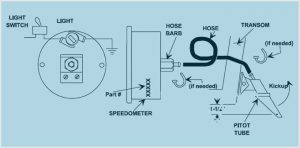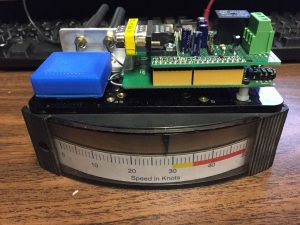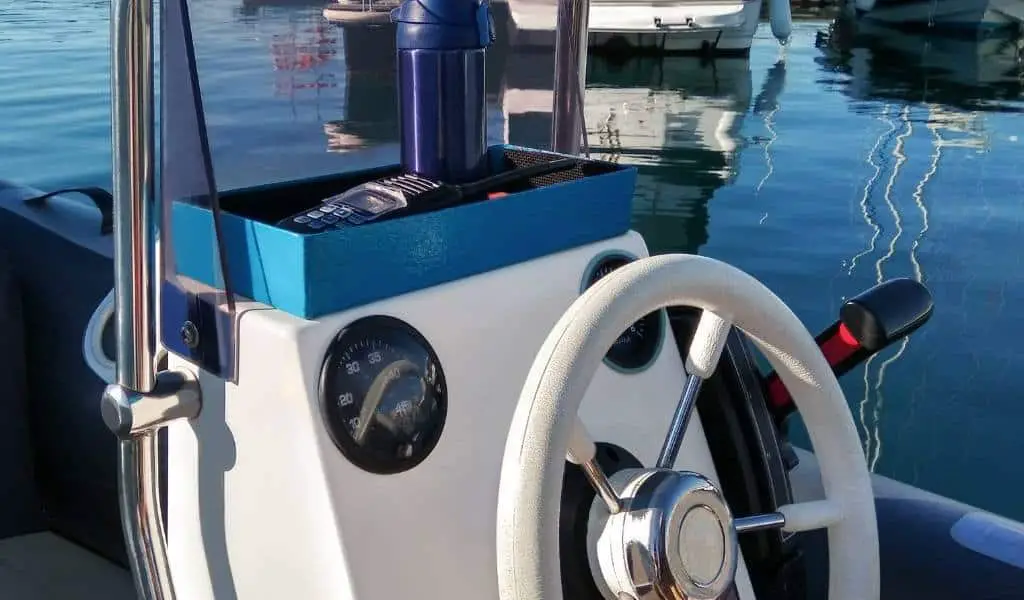If you own a powerboat, chances are pretty high that it has a speedometer. These nifty devices allow you to quickly and accurately gauge your vessel’s speed so that you can better navigate and avoid damaging your boat.
A speedometer is an instrument that provides a readout of your boat’s speed. Your boat may be fitted with either a pitot tube, also known as a pitometer, or a GPS gauge. Each one measures your speed and provides a display for your use. The primary differences are the accuracy and cost.
That being said, there are so many different kinds of speedometers out there that it’s easy to get overwhelmed by all of the options available to you if you’re in the market for a new model. Additionally, speedometer care and repair are often-overlooked parts of your regular boat maintenance, so we’ve put together this ultimate guide to speedometers, complete with all the information you need to get out on the water. Let’s get to it!
What is a Speedometer?

Simply put, a speedometer is an instrument that measures and displays the current speed of a vehicle or vessel. Speedometers are currently found on all motor vehicles and are common on most steering wheel-operated boats with a console display area.
However, the types of speedometers found on land-based vehicles are actually different from those found on marine vessels. For motor vehicles, your speed on the road is the same as your speed through space. For boats, your speed through the water is much more important than your speed through space.
This might sound a bit nitpicky, but if you’re driving a boat against a strong tide, your actual speed in the water will be different than your speed through space as you will be pushed back against the tide.
Knowing exactly how fast you’re moving from A to B is essential for time planning and calculating if you have enough fuel to complete your journey.
How Does a Boat Speedometer Work?
When buying a speedometer for your boat, you actually have a choice between a manual speedometer and a GPS-based speedometer, these both provide estimates of your speed, however, they work in very different ways.
- A manual speedometer, also known as a pitometer, measures the movement of your boat against the speed of the water. It works by using a pitot tube which travels along the surface of the sea or lake and fills with water. The change in air pressure from the water gives an instantaneous estimate of your speed which is fed back to the speedometer on your dashboard.
- A GPS-based speedometer shows you how quickly your boat is moving through space. It does this by measuring how quickly your vessel is going from one position to the next every nanosecond, to give you an instantaneous speed reading on your console dashboard. This is the same type of technology found in your cars sat nav or your mobile phone.
Is a Manual or GPS-Based Speedometer Better?
A GPS-based speedometer is the best choice for your boat as it is more accurate than a manual speedometer and isn’t influenced by odd currents or the wind. They are also much easier to install, however, they can be impacted by particularly bad weather as they rely on a GPS connection.
If your boat is already set-up for a manual speedometer, this is probably your best bet as you will already have holes cut in your boat which makes the installation process much easier. However, if you’re starting from scratch, you can mount a GPS-based model onto your vessel with little extra legwork.
How Accurate is a Boat Speedometer?
If you buy a speedometer, you’ll want to be sure that you’ve spent your hard-earned money on something that actually works. When it comes to speedometers, there’s a wide range in accuracy, depending on both the model you buy, how you mount it on your boat, and whether it’s a GPS-based unit or a pitometer.
For the most part, pitometers are going to be less accurate than GPS models, but, as we’ve mentioned, a GPS won’t tell you your speed through the water, just in space. Pitometers are finicky, to say the least, and any sort of kinks or issues with the internal pitot tube can cause errors in accuracy.
So, if you want a speedometer that’s always going to be accurate in telling you your speed through space, a GPS-based model is the way to go.
Testing the Accuracy of Your Speedometer
If you’re concerned that your boat’s speedometer isn’t quite accurate, you might want to test it. While there are ways to test the actual pressure in the pitot tube (if using a pitometer), these are notoriously inaccurate and complicated.
Instead, a simple way to test the accuracy of your speedometer is to use a GPS-based speed app on your phone as you cruise around on a day with minimal wind and calm seas. You may have to account for the tide, but if you can get a similar enough reading between the GPS-based speed app and your pitometer, all is likely well.
Choosing a Speedometer for a Boat
Now that you understand some key bits of information about speedometers, it’s time to discuss how you can go about choosing one for your boat. Here are some things to look out for:
1. GPS v. Manual

We’ve already covered this in pretty good detail, so we won’t spend too much time on this. Basically, you’ll need to decide if you want to go with a manual or a GPS-based speedometer in your boat.
As we’ve mentioned, GPS models tend to be more accurate, but if you already have holes cut into your boat for a manual speedometer, it might be worth replacing it. But, modern GPS units are incredibly accurate, and their sleek, stylish look might be enough to sway you.
2. Cost
Generally speaking, GPS-based speedometers cost more than their pitot tube counterparts, so this might sway your decision. However, the accuracy, ease of installation, and simplicity of a GPS unit might make it worth the extra upfront cost. Plus, GPS units usually require minimal care and maintenance, while pitot tube models need to be tended to frequently, which can increase your costs over time.
3. Installation
For the most part, GPS-based speedometers are easier to install than pitot tube speedometers. Since pitot tube models need to have a pressure tube that sits in the water but connects to the display on your dashboard, there are more holes to drill, making it a more labor-intensive installation process. Thus, if you’d prefer to get the installation done with quickly, a GPS-based speedometer might be for you.
Related article: Where should a boat compass be mounted
What’s the Best Speedometer For Boats?
Here are my recommended speedometers for your boat:
Best GPS Speedometer: Eling GPS Speedometer
My top pick is this Eling GPS speedometer with curved glass display and red backlight. This is very easy to install and shouldn’t take longer than 15 minutes.
The dial has a white faceplate that is very easy to read and displays up to 80MPH (130KM/H). I like that it has a very quick start-up time of around 3 seconds.
It comes with the GPS sensor and wire for attaching to the speedometer once installed.
Best Digital Speedometer: Eling Universal Digital Speedometer
If you prefer a digital dial rather than the traditional style, this universal speedometer is a good choice. This is also GPS-based so it’s very similar to the previous speedometer from Eling, however, as it’s digital there is no limit on the speed that can be displayed.
It is IP67 rated and has a range of 7 backlight colors to choose between. It will fit in an 85mm hole and comes with the GPS antenna which can be mounted on the top of the dash.
Best Manual Speedometer (Pitometer): Sierra International Eclipse
If your boat is already kitted out for a pitometer, then I recommend the Eclipse kit from Sierra International. It includes a 3″ white and blue dial with perimeter backlight so that you can easily see it at night. The kit also comes with the pitot and hose included so you only need to purchase one product.
How to Install a Speedometer on a Boat
Properly installing a speedometer on your boat is critical to ensuring that it is accurate and effective over time. If the speedometer isn’t installed correctly, you can end up with vastly inaccurate speed measurements, which can put you and your boat at risk.
When it comes to installing a speedometer, you have two options: do it yourself, or pay a professional. Here’s what those two options would look like:
Option 1: Do It Yourself
Installing a speedometer on your boat doesn’t have to be an impossible task. In fact, depending on the kind of speedometer, the process can actually be quite simple. Here’s what you have to do:
How to Install GPS Speedometers
There are three main steps to installing a GPS speedometer:
- Decide where you want to mount the GPS display on your instrument panel. Once you find the right spot, you’ll drill a hole in the panel, according to the device’s instructions, and insert the speedometer. Secure the speedometer and its mounting bracket to the back of the panel as described by the instruction manual.
- Connect the device to a source of 12-volt power. The vast majority of GPS speedometers need some sort of ground connection and two 12-volt power connections. One of these connections is used for the backlight, and the other is important for running the actual device. Usually, the other instruments on your boat will already be connected to good power sources, which your speedometer can share.
How to Install Pitot Tube Speedometers
Pitot tube speedometer installation is a bit more complicated than GPS model installation, but it’s not impossible.
To get started, I recommend getting this SeaChoice Pitot Speedometer Kit which comes with everything you need to install a pitot on the outer surface of your boat. The kit includes a flexible pitot that can pivot, a black plastic vent, black plastic tube holders, self-tapping screws, and 20 feet of PVC tubing.
Here are step-by-step instructions to install a pitot tube speedometer:
- Drill a hole in your instrument panel to mount the speedometer display. Follow the device’s instruction manual to ensure you’re drilling the correct size hole and securing the mounting bracket appropriately.
- Determine what route your pressure tube will take in your boat. The speedometer display is connected to the pitot using a stiff tube that can transfer water pressure from the pitot to the display’s sensor. The tube itself has to be downward sloping at all times because any sags in the tube can cause water to collect inside and mess with the instrument’s accuracy.
- Decide where on the transom you will mount the pilot tube. The pitot tube should sit somewhere that’s clear of all potential sources of damage, such as rudders, propellers, trim tabs, and strakes. The pitot tube’s tip should be at least two inches below the hull.
- Once you find a good spot to mount the pitot tube, you can screw the pitot bracket into the transom, making sure that the pitot points directly downward.
- Drill a hole in the transom for the pressure tube. The hole should be well above the waterline and should be angled downward about 45 degrees. Insert the pressure tube into the hole and connect it to the pitot.
- Secure the pressure tube in place using cable clips and sealant. The other end of the pressure tube should be connected to the speedometer display.
Option 2: Professional Installation
If do it yourself projects just aren’t your thing, you can always pay a professional to install your speedometer for you. As we’ve mentioned, this isn’t an overly complex process, so it should take an experienced marine mechanic much time at all.
In general, if you provide all of the parts, a professional should be able to complete the project in well under an hour. Thus, depending on the rates at your local marine shop, paying someone to install your speedometer won’t break the bank too terribly much.
Repair and Maintenance of Your Speedometer
Like any good piece of marine equipment, speedometers need frequent repair and maintenance to stay in good working conditions. When it comes to GPS speedometers, so long as they have a good electrical connection and the software stays up to date, there’s really not too much you need to do by way of repairs.
If you’re having problems with your pitot tube speedometer, the source of the issue is likely the tube itself. To identify and fix the problem, you’ll want to take a look at the tube and check it for holes and cuts. If there’s no obvious damage, you’ll want to make sure there’s no water collecting in the tube, causing it to sag and give an inaccurate reading.
Should that not solve your problems, you may need to replace the tube. Thankfully, the tube isn’t too terribly expensive, so you should be able to get some from your local marine shop without spending too much money. Just be sure to buy the same length tube as you had before to avoid any potential problems.
Generally, installing a new tube will solve most problems, but if not, it may be time to get a professional involved. These devices are notoriously tricky, so it’s worth getting help with repairs if you’re not completely certain what the issue is.








